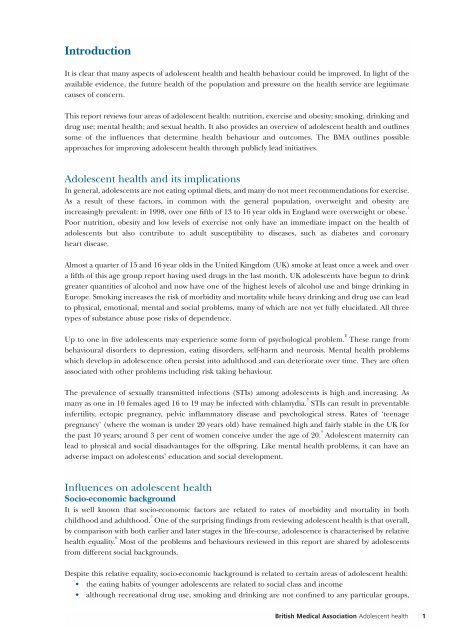Alcohol misuse: tackling the UK epidemic - London
Alcohol misuse: tackling the UK epidemic - London
Alcohol misuse: tackling the UK epidemic - London
Create successful ePaper yourself
Turn your PDF publications into a flip-book with our unique Google optimized e-Paper software.
Introduction<br />
It is clear that many aspects of adolescent health and health behaviour could be improved. In light of <strong>the</strong><br />
available evidence, <strong>the</strong> future health of <strong>the</strong> population and pressure on <strong>the</strong> health service are legitimate<br />
causes of concern.<br />
This report reviews four areas of adolescent health: nutrition, exercise and obesity; smoking, drinking and<br />
drug use; mental health; and sexual health. It also provides an overview of adolescent health and outlines<br />
some of <strong>the</strong> influences that determine health behaviour and outcomes. The BMA outlines possible<br />
approaches for improving adolescent health through publicly lead initiatives.<br />
Adolescent health and its implications<br />
In general, adolescents are not eating optimal diets, and many do not meet recommendations for exercise.<br />
As a result of <strong>the</strong>se factors, in common with <strong>the</strong> general population, overweight and obesity are<br />
increasingly prevalent: in 1998, over one fifth of 13 to 16 year olds in England were overweight or obese. 1<br />
Poor nutrition, obesity and low levels of exercise not only have an immediate impact on <strong>the</strong> health of<br />
adolescents but also contribute to adult susceptibility to diseases, such as diabetes and coronary<br />
heart disease.<br />
Almost a quarter of 15 and 16 year olds in <strong>the</strong> United Kingdom (<strong>UK</strong>) smoke at least once a week and over<br />
a fifth of this age group report having used drugs in <strong>the</strong> last month. <strong>UK</strong> adolescents have begun to drink<br />
greater quantities of alcohol and now have one of <strong>the</strong> highest levels of alcohol use and binge drinking in<br />
Europe. Smoking increases <strong>the</strong> risk of morbidity and mortality while heavy drinking and drug use can lead<br />
to physical, emotional, mental and social problems, many of which are not yet fully elucidated. All three<br />
types of substance abuse pose risks of dependence.<br />
Up to one in five adolescents may experience some form of psychological problem. 2<br />
These range from<br />
behavioural disorders to depression, eating disorders, self-harm and neurosis. Mental health problems<br />
which develop in adolescence often persist into adulthood and can deteriorate over time. They are often<br />
associated with o<strong>the</strong>r problems including risk taking behaviour.<br />
The prevalence of sexually transmitted infections (STIs) among adolescents is high and increasing. As<br />
many as one in 10 females aged 16 to 19 may be infected with chlamydia. 3<br />
STIs can result in preventable<br />
infertility, ectopic pregnancy, pelvic inflammatory disease and psychological stress. Rates of ‘teenage<br />
pregnancy’ (where <strong>the</strong> woman is under 20 years old) have remained high and fairly stable in <strong>the</strong> <strong>UK</strong> for<br />
<strong>the</strong> past 10 years; around 3 per cent of women conceive under <strong>the</strong> age of 20. 4<br />
Adolescent maternity can<br />
lead to physical and social disadvantages for <strong>the</strong> offspring. Like mental health problems, it can have an<br />
adverse impact on adolescents’ education and social development.<br />
Influences on adolescent health<br />
Socio-economic background<br />
It is well known that socio-economic factors are related to rates of morbidity and mortality in both<br />
childhood and adulthood. 5<br />
One of <strong>the</strong> surprising findings from reviewing adolescent health is that overall,<br />
by comparison with both earlier and later stages in <strong>the</strong> life-course, adolescence is characterised by relative<br />
health equality. 6<br />
Most of <strong>the</strong> problems and behaviours reviewed in this report are shared by adolescents<br />
from different social backgrounds.<br />
Despite this relative equality, socio-economic background is related to certain areas of adolescent health:<br />
• <strong>the</strong> eating habits of younger adolescents are related to social class and income<br />
• although recreational drug use, smoking and drinking are not confined to any particular groups,<br />
British Medical Association Adolescent health 1
















